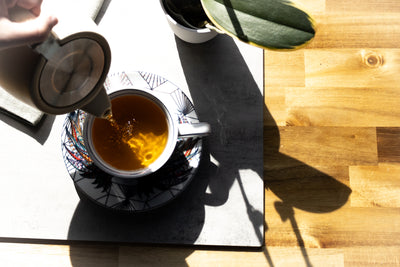Like wine or beer, tea is not drinkable in its raw form. It needs to undergo processing before it becomes a shelf-stable and drinkable product.
Table of Contents
Withering
Withering - This is when some, but not all, of the moisture is removed from the leaves. This starts as soon as the tea leaf is plucked. Tea producers need to make sure that the leaves are withered evenly and until the desired percentage of water loss is achieved. This could be measured by the before and after weight of the tea, how the leaves feel, or the aroma they produce. As the tea withers longer, caffeine will increase, chlorophyll will break down, and oxidation will start. Green tea usually has the shortest wither.
Once the tea is withered, the next step for some tea is rolling.
Rolling
The tea is rolled to break open the cellular walls, which allows the juices inside the leaf to combine and interact with air. This aids in giving the tea its signature flavor. Many green teas skip the rolling step or just get shaped enough to prevent the walls from breaking. Rolling is performed using different methods depending on the tea type. Some are tumbled or shaken in cylinders, others using a mechanical rolling machine (two plates that rub together), or in rare cases - by hand. Other tea types like Oolong, black tea, and Pu-erh are all rolled during processing.
Oxidation
Take an apple slice and leave it out; it will turn brown. The same thing happens with tea! It will turn from green to black the longer it is exposed to air. This is the result of a chemical process. Green tea contains catechins which are the antioxidant chemical compounds in tea that belong to the subgroup known as flavonoids. Those get converted to Theaflavins and Thearubigins which give darker teas their color and “bold/brisk” characteristics. Chlorophyll also starts to break down, and there are numerous other chemical reactions that produce all the ranges of aromas and tastes. Green tea is not allowed to oxidize, hence the green color. Oolong tea can go on a spectrum from green to almost black - depending on the specific variety.
Fixing / Drying
This is the part of the process where oxidation is stopped. Using the same analogy as an apple - baking an apple will stop it from turning brown. There are a variety of different ways to fix the teas:
Sun Drying
Heat from the sun can slowly stop oxidation.
Blanching
Just like veggies, the leaves are scalded with boiling water.
Tumbling
Cylinders are heated, and the leaves are tumbled within (think of a clothes dryer).
Baking
Using specially designed ovens.
Pan Roasting
Used for Chinese green teas. Picture a big dry wok and tumbling the leaves like a stir fry. Processing this way imparts more of a toasty flavor.
Steaming
The Japanese method gives the tea more vegetal/seaweed flavors.
Drying
The final process, where the tea is heated up to remove all the moisture and make it shelf-stable, with the goal of 97+% of the moisture removed. As with the other steps of processing, care must be taken so that the tea is dried at the right pace - too quick or too slow will result in inferior tea.
As with the other steps of processing, care must be taken so that the tea is dried at the right pace - too quick or too slow will result in inferior tea.
As with other methods, the sun is a traditional, but not a popular way of drying. Some use special conveyor belts/ovens. Another method is a fluidized bed dryer- where tea leaves are conveyed over a perforated bed. Hot air is blown through the holes of a perforated plate. The tea is lifted from the bottom and causes it to behave as a fluid. Think of it like one of those interior sky diving rides.The tea is suspended and twirling as moisture is removed.

